15 White Birds In Michigan (Pictures And Description)
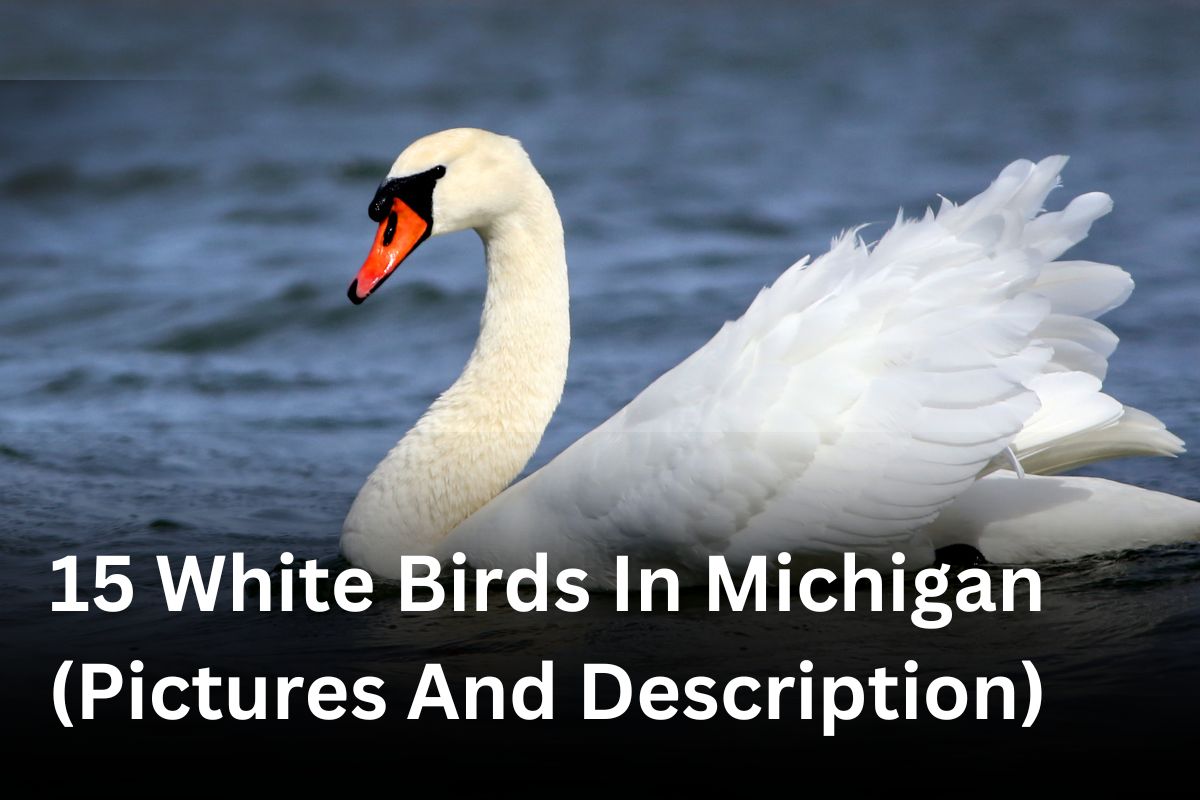
If you’re a bird lover, Michigan is your place to be. It’s a home to many bird species, and some stopover during their migration. In this post, we’re discussing 15 incredible birds you can spot in Michigan. We’re covering everything from the impressive Great Egret to the elusive Snowy Owl, discussing their habitats, appearance, locations, size, diet, and identification.
List Of 15 White Birds In Michigan
Rock Pigeon
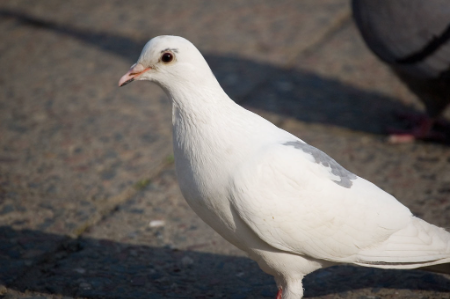
Where in Michigan does it find: Rock Pigeons are urban dwellers and can be found throughout Michigan, especially in cities and towns.
Description of the bird: Rock Pigeons are medium-sized birds with a bluish-gray body and distinctive iridescent patches on their necks. They are known for their adaptability and are often seen perched on buildings and ledges. Also, some rock pigeon are totally white.
Where to find this bird: Look for Rock Pigeons in urban environments, parks, and around buildings.
Size of the bird, size of wings, weight of the bird:
Size: 12-14 inches
Wingspan: 20-26 inches
Weight: 9-13 ounces
Diet: Rock Pigeons primarily feed on seeds, grains, and human scraps. They are well-known for their scavenging behavior.
How to identify: Identify Rock Pigeons by their gray-blue plumage, iridescent neck patches, and distinctive cooing sounds.
Ring-Billed Gull
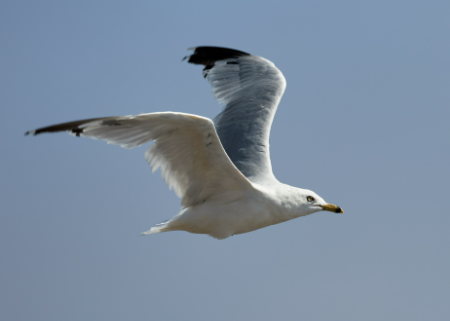
Where in Michigan does it find: Ring-Billed Gulls are commonly found near lakes and rivers across Michigan, especially during the breeding season.
Description of the bird: These gulls have white plumage with gray wings and a distinctive black ring around their yellow bills.
Where to find this bird: Ring-Billed Gulls are often seen near freshwater bodies like lakes, rivers, and even in urban areas.
Size of the bird, size of wings, weight of the bird:
Size: 16-18 inches
Wingspan: 38-50 inches
Weight: 9-25 ounces
Diet: Their diet includes fish, insects, and scavenged human food.
How to identify: Look for the black ring around their bill, yellow legs, and a white head with gray wings.
Great Egret
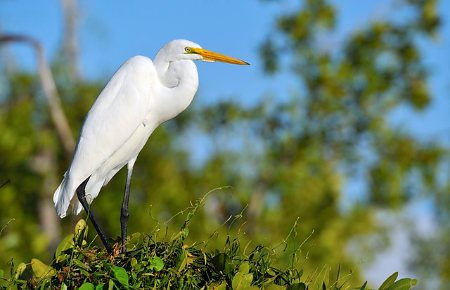
Where in Michigan does it find: Great Egrets are commonly found in wetlands, marshes, and along the shores of lakes and rivers across Michigan.
Description of the bird: These graceful birds are tall with all-white plumage, long necks, and sharp, yellow bills.
Where to find this bird: Look for Great Egrets in wetlands, shallow waters, and along the edges of bodies of water.
Size of the bird, size of wings, weight of the bird:
Size: 35-41 inches
Wingspan: 55-65 inches
Weight: 2-3 pounds
Diet: Great Egrets primarily feed on fish, frogs, and aquatic invertebrates.
How to identify: Their large size, all-white plumage, and distinctive S-shaped neck make them easily recognizable.
Mute Swan
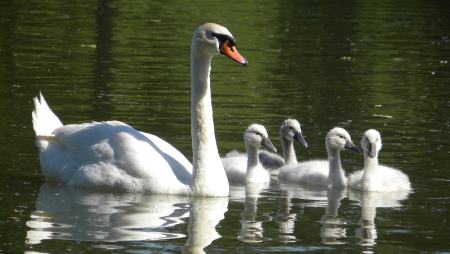
Where in Michigan does it find: Mute Swans can be found in various wetland habitats and ponds across Michigan.
Description of the bird: Mute Swans are large, with white plumage, long necks, and distinctive orange bills.
Where to find this bird: Look for Mute Swans in ponds, lakes, and slow-moving rivers.
Size of the bird, size of wings, weight of the bird:
Size: 55-63 inches
Wingspan: 7-8 feet
Weight: 20-30 pounds
Diet: They primarily feed on aquatic plants, but also consume small aquatic animals.
How to identify: Identify Mute Swans by their elegant, curved necks and distinctive orange bills.
Snow Goose
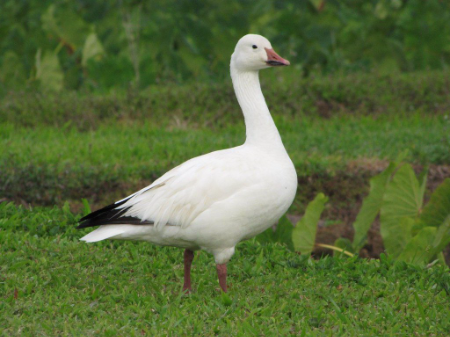
Where in Michigan does it find: Snow Geese can be found in Michigan during their migration periods, often in wetlands and agricultural fields.
Description of the bird: Snow Geese are medium-sized, with white plumage and distinctive black wingtips. Their name comes from their snow-white appearance.
Where to find this bird: Look for Snow Geese in wetlands, agricultural fields, and along migration routes.
Size of the bird, size of wings, weight of the bird:
Size: 20-28 inches
Wingspan: 53-65 inches
Weight: 3-6 pounds
Diet: They primarily feed on grasses, sedges, and grains during their migration.
How to identify: Snow Geese are characterized by their white plumage with black wingtips and a pink bill.
Gyrfalcon
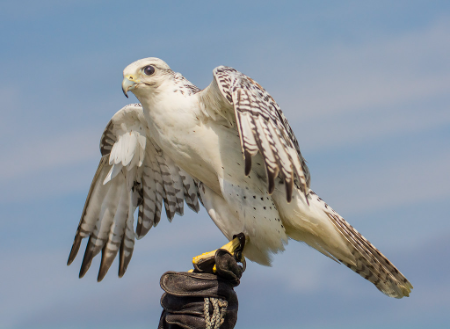
Where in Michigan does it find: Gyrfalcons are rare winter visitors to Michigan, particularly in the northern regions.
Description of the bird: Gyrfalcons are large raptors with varying plumage colors, from white to gray to dark brown. They have sharp beaks and powerful talons.
Where to find this bird: Look for Gyrfalcons in open habitats, tundra, and occasionally in wooded areas during their winter visits.
Size of the bird, size of wings, weight of the bird:
Size: 19-24 inches
Wingspan: 43-51 inches
Weight: 2-5 pounds
Diet: Gyrfalcons are skilled hunters, preying on birds and small mammals.
How to identify: Their large size, powerful build, and varied plumage make them stand out among raptors.
Great Blue Heron
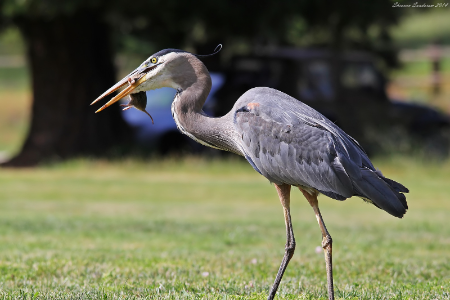
Where in Michigan does it find: Great Blue Herons are widespread in Michigan and can be spotted in wetlands, lakeshores, and rivers.
Description of the bird: These large birds have blue-gray plumage, long legs, and a distinctive S-shaped neck. They are known for their patient hunting behavior.
Where to find this bird: Look for Great Blue Herons in shallow waters, marshes, and along the edges of lakes and rivers.
Size of the bird, size of wings, weight of the bird:
Size: 38-54 inches
Wingspan: 65-79 inches
Weight: 4-6 pounds
Diet: Great Blue Herons mainly feed on fish, frogs, and small mammals.
How to identify: They are unmistakable with their tall stature, long neck, and blue-gray plumage.
Trumpeter Swan

Where in Michigan does it find: Trumpeter Swans are found in wetlands, ponds, and lakes across Michigan, with the largest populations in the northern part of the state.
Description of the bird: These swans are massive and all-white with a long, straight neck and a distinctive black bill.
Where to find this bird: Look for Trumpeter Swans in wetlands, especially in northern Michigan.
Size of the bird, size of wings, weight of the bird:
Size: 50-60 inches
Wingspan: 7-8 feet
Weight: 17-30 pounds
Diet: Their diet consists mainly of aquatic plants, but they also eat small aquatic animals.
How to identify: Identify Trumpeter Swans by their massive size, all-white plumage, and straight black bill.
Snowy Owl
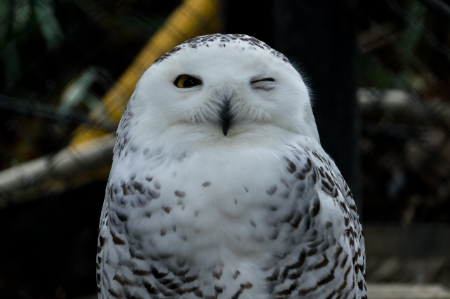
Where in Michigan does it find: Snowy Owls visit Michigan during the winter months, particularly in open areas and along shorelines.
Description of the bird: Snowy Owls are large, with white plumage, yellow eyes, and a round head. They are well adapted to cold climates.
Where to find this bird: Look for Snowy Owls in open fields, beaches, and dunes during their winter migration.
Size of the bird, size of wings, weight of the bird:
Size: 20-28 inches
Wingspan: 49-59 inches
Weight: 3-6 pounds
Diet: Snowy Owls primarily hunt small mammals, especially rodents and lemmings.
How to identify: Snowy Owls are unmistakable with their all-white plumage and piercing yellow eyes.
Cattle Egret
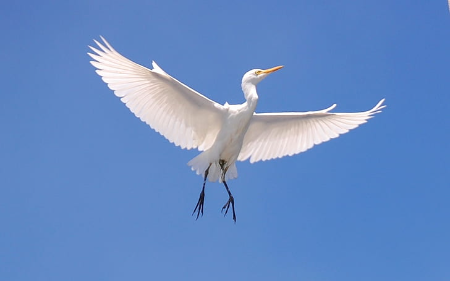
Where in Michigan does it find: Cattle Egrets are sporadic visitors to Michigan, primarily during the summer months. They can be found in agricultural areas and wetlands.
Description of the bird: These small herons have white plumage, a yellow bill, and often display orange breeding plumage on their head and neck.
Where to find this bird: Look for Cattle Egrets in agricultural fields, pastures, and wetlands, especially when cattle or other livestock are present.
Size of the bird, size of wings, weight of the bird:
Size: 18-22 inches
Wingspan: 36-38 inches
Weight: 8-12 ounces
Diet: Cattle Egrets feed on insects, particularly those disturbed by livestock, and occasionally small vertebrates.
How to identify: Identify Cattle Egrets by their small size, white plumage, and yellow bill, particularly during the breeding season when they have orange plumage on their head and neck.
Snow Bunting
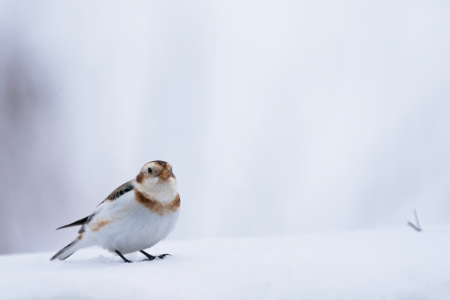
Where in Michigan does it find: Snow Buntings are winter visitors to Michigan, particularly in open, snow-covered fields.
Description of the bird: Snow Buntings are small, with white plumage and distinctive black wingtips. During the breeding season, males develop a black and white plumage.
Where to find this bird: Look for Snow Buntings in open fields, agricultural areas, and along shorelines during the winter.
Size of the bird, size of wings, weight of the bird:
Size: 5-7 inches
Wingspan: 11-14 inches
Weight: 1-2 ounces
Diet: Their diet primarily consists of seeds and small invertebrates, especially during the winter.
How to identify: Identify Snow Buntings by their small size, white plumage with black wingtips, and in males, their striking black and white breeding plumage.
Herring Gull

Where in Michigan does it find: Herring Gulls are commonly found along the shores of the Great Lakes in Michigan.
Description of the bird: Herring Gulls are large with gray wings and backs, white heads, and yellow bills with a red spot.
Where to find this bird: Look for Herring Gulls near large bodies of water, particularly the Great Lakes.
Size of the bird, size of wings, weight of the bird:
Size: 22-26 inches
Wingspan: 54-60 inches
Weight: 1.5-3 pounds
Diet: Herring Gulls are opportunistic feeders and consume a variety of fish, invertebrates, and even human food scraps.
How to identify: Identify Herring Gulls by their size, gray wings, and red-spotted yellow bills.
White-breasted Nuthatch
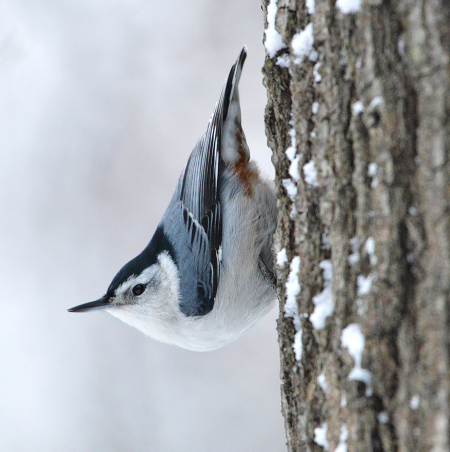
Where in Michigan does it find: White-breasted Nuthatches are year-round residents of Michigan and can be found in forests, woodlands, and suburban areas.
Description of the bird: These small birds have a blue-gray back, a white face and breast, and a distinctive black cap on their head. They are known for their habit of climbing down trees headfirst.
Where to find this bird: Look for White-breasted Nuthatches in deciduous and coniferous forests, where they forage for insects and seeds.
Size of the bird, size of wings, weight of the bird:
Size: 5.5-6 inches
Wingspan: 8.7-10 inches
Weight: 0.74-1.06 ounces
Diet: White-breasted Nuthatches feed on insects, seeds, and nuts, often wedging nuts into tree bark and using their bills to crack them open.
How to identify: Identify them by their small size, white face, black cap, and their habit of crawling down tree trunks headfirst.
American White Pelican
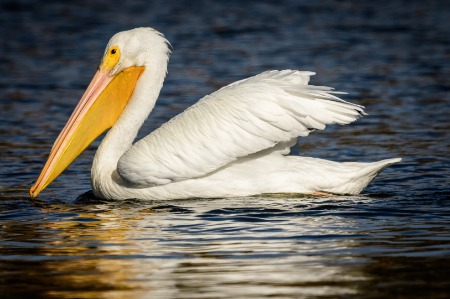
Where in Michigan does it find: American White Pelicans visit Michigan during the summer months, primarily in the western part of the state, near larger lakes and rivers.
Description of the bird: These large white pelicans have a distinctive long bill and black wingtips visible in flight.
Where to find this bird: Look for American White Pelicans in large freshwater lakes, rivers, and marshes during the summer breeding season.
Size of the bird, size of wings, weight of the bird:
Size: 50-67 inches
Wingspan: 108-120 inches
Weight: 9-20 pounds
Diet: They are primarily piscivorous, feeding on fish by swimming on the water’s surface and scooping them up in their large bill pouches.
How to identify: Identify American White Pelicans by their large size, long bill, and striking black-edged wings when in flight.
Ross’s Goose
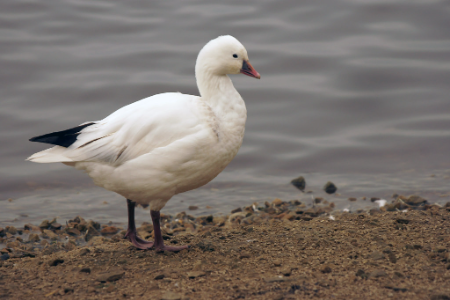
Where in Michigan does it find: Ross’s Geese are occasional visitors to Michigan during their migrations, typically in wetlands and agricultural areas.
Description of the bird: These small geese are white with a round head and a stubby bill.
Where to find this bird: Look for Ross’s Geese in wetlands, agricultural fields, and alongside other waterfowl during migration.
Size of the bird, size of wings, weight of the bird:
Size: 20-28 inches
Wingspan: 42-45 inches
Weight: 1.8-3 pounds
Diet: Ross’s Geese primarily feed on grasses and aquatic vegetation.
How to identify: Identify Ross’s Geese by their small size, all-white plumage, and their stubby bill.






